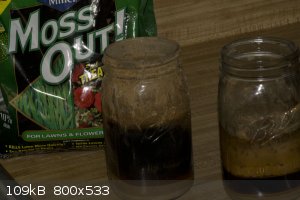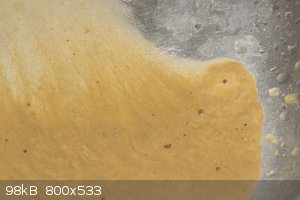ScopeGuy
Harmless

Posts: 14
Registered: 20-11-2015
Member Is Offline
Mood: No Mood
|
|
Ferrous Sulfate Heptahydrate
I wanted to try to make some Crystals out of
Ferrous Sulfate Heptahydrate
https://www.youtube.com/watch?v=tjBhumIr3OM
Anyone know where to get it? Lowes or Homedepot or some type of place I could pick it up locally.
I have some Ferrous sulfate monohydrate I do not know if that will work.
I looked in the forum and saw a few ways to make it with sulfuric acid but I want to be able to hold the crystals so I was looking for a safer way to
make them.
Thank you
|
|
|
JJay
International Hazard
    
Posts: 3440
Registered: 15-10-2015
Member Is Offline
|
|
Dissolving ferrous sulfate monohydrate in room temperature water will give you a solution of the heptahydrate. Removing the water of solution is a bit
tricky since oxygen will destroy the ferrous sulfate chemically and heat will alter the heptahydrate complex... but you can do it under vacuum below
56.6 C.
Making it from sulfuric acid shouldn't make handling the crystals a problem as long as you completely neutralize the acid and wash/recrystalize the
product, but of course that also requires working with sulfuric acid, so it's not ideal....
[Edited on 21-12-2015 by JJay]
|
|
|
Amos
International Hazard
    
Posts: 1406
Registered: 25-3-2014
Location: Yes
Member Is Offline
Mood: No
|
|
If you don't have as much ferrous sulfate as you'd like already, you can do a single-replacement reaction between a solution of copper(II) sulfate
(available in most hardware stores as root killer) and steel wool, usually with a tiny amount of catalytic sodium chloride added.
|
|
|
Texium
|
Thread Moved
20-12-2015 at 20:57 |
ScopeGuy2
Harmless

Posts: 17
Registered: 24-12-2015
Member Is Offline
Mood: No Mood
|
|
Thank you both so much. I could not sign back on here for some reason. I had to create a new account but wanted to wait a few days and
unsuccessfully tried to get it to work.
I got Copper II sulfate and the steel wool today. 2 pounds to try to make the ferrous sulfate and 2 pounds for some thing else at a later time.
Is there any instructions how to make the ferrous and the amounts of everything that I should use.
Thank you
|
|
|
Texium
Administrator
       
Posts: 4516
Registered: 11-1-2014
Location: Salt Lake City
Member Is Online
Mood: PhD candidate!
|
|
Well, do you remember stoichiometry from high school? It'll come in handy for things like this. Here's your equation:
CuSO4 + Fe —> FeSO4 + Cu
It's a single replacement reaction, and a 1:1 molar ratio, so you'll need to find the molar masses of each of your reactants, and that will tell you
how much of each you need to use.
|
|
|
Amos
International Hazard
    
Posts: 1406
Registered: 25-3-2014
Location: Yes
Member Is Offline
Mood: No
|
|
In addition, your steel wool should be as fine as possible, and you'll want to use more steel wool than copper sulfate in the stoichiometry; this will
prevent any copper sulfate from remaining afterward. Give it a stir every now and then while it reacts so that your steel wool doesn't get covered in
copper and prevent it from fully reacting. At the end, you can just filter the solution and then either chill it or boil it down a bit to crystallize
it.
|
|
|
ScopeGuy2
Harmless

Posts: 17
Registered: 24-12-2015
Member Is Offline
Mood: No Mood
|
|
Very useful thank you.
So I figured out that 2 pounds of CuSO4 =5.66 moles
I would need 1.06 pounds of steel wool
Then add a little extra steel wool
What should I do to figure out how much water to add when mixing the steel wool with the CuSO4? How do I figure out how much water I need?
Also how much sodium chloride should I add?
|
|
|
Xenoid
National Hazard
   
Posts: 775
Registered: 14-6-2007
Location: Springs Junction, New Zealand
Member Is Offline
Mood: Comfortably Numb
|
|
ScopeGuy2 - Why are you MAKING ferrous sulphate, you have stated in your first post that you already have some!
Ferrous sulphate can be made to crystallise with several different amounts of "water of crystallisation". Under normal circumstances it will
crystallise with 7 water molecules (the heptahydrate).
Just dissolve your MONOhydrate as in the video, it will crystallise as the heptahydrate.
You should note however the crystals will soon oxidise and get a rusty coating of Fe2O3, they will not remain the pristine emerald appearance unless
special precautions are taken!
|
|
|
ScopeGuy2
Harmless

Posts: 17
Registered: 24-12-2015
Member Is Offline
Mood: No Mood
|
|
I do have some ferrous sulphate. I guess the reason I want to make it is to make more is because it sounded fun when I heard that it could be made
from copper sulfate. I figure that I will probably need more in a few years and thought why not make it now. I am a new to making chemicals, unlike
all the experts on here, there are a few things that I want to make but they are acids and it scares me some. I thought it would be great to make
some thing simple and less dangerous first.
I wanted to make the ferrous crystals because I don't have them.
I will give the crystals a try tomorrow to see how it works
|
|
|
Amos
International Hazard
    
Posts: 1406
Registered: 25-3-2014
Location: Yes
Member Is Offline
Mood: No
|
|
Let the solution of copper sulfate with the steel wool sit for a while and see if you see signs of reaction; I doubt you'll actually need any
chloride, it simply accelerates the start of the reaction. I would use as little water as is needed to ensure all of the copper(II) sulfate dissolves.
If it looks like ferrous sulfate crystals are appearing midway through the reaction and they're getting in the way, you can add more water and begin
heating it all on a hot plate to keep any soluble compounds dissolved.
At the conclusion of the reaction, filter the solution as quickly as possible, boil it down a bit, and while still hot, put it into a container with
as little room for air at the top as possible. Put a lid on this container and cool the whole thing down to force crystallization to occur. The larger
the amount of solution you have, and the slower the gradual cooling process is, the larger and more attractive your crystals will be. If you're
satisfied with the crystals you produce, pour off the remaining solution, saving it for later to produce more crystals, and immediately dry off the
crystals you've produced with a paper towel; they're much more prone to air oxidation when they're wet on the surface. Larger, more richly crystals
with fewer inclusions in my experience are also less prone to oxidation than their smaller, grainier relatives, so keep this in mind as well.
If at any time you notice a significant color change in your solution to a more nasty yellowish-green or even brownish, you've encountered partial
oxidation of your iron(II) sulfate solution. Small amounts of this aren't too important, but if it appears drastic, you can add a few mL of sulfuric
acid to the solution and place it in a NEARLY airtight container with any source of iron metal. This will slowly reduce it back.
[Edited on 12-28-2015 by Amos]
|
|
|
ScopeGuy2
Harmless

Posts: 17
Registered: 24-12-2015
Member Is Offline
Mood: No Mood
|
|
Thank you all vey much,
I will post a few photos when I get this done
|
|
|
ScopeGuy2
Harmless

Posts: 17
Registered: 24-12-2015
Member Is Offline
Mood: No Mood
|
|
So I checked to see if I got any crystals and nothing

|
|
|
ScopeGuy2
Harmless

Posts: 17
Registered: 24-12-2015
Member Is Offline
Mood: No Mood
|
|
I check with a plastic spoon and nothing and just sediment when I dumped it out. I will try again with sulfuric acid next time

|
|
|
mnm0003
Harmless

Posts: 10
Registered: 5-1-2016
Location: Italy
Member Is Offline
Mood: No Mood
|
|
Reply
Quiet! FeSO4 are to combat moss and algae in any store or farmers' cooperatives erboresteria  in general is heptahydrate (maximum degree of hydration) but you can eliminate water molecules by controlled heating (see some TGA you
have to be careful not decompose) or reach the heptahydrate for dissolution and crystallization in general is heptahydrate (maximum degree of hydration) but you can eliminate water molecules by controlled heating (see some TGA you
have to be careful not decompose) or reach the heptahydrate for dissolution and crystallization
Attachment: TGA DI ALCUNI SOLFATI.pdf (1.1MB)
This file has been downloaded 484 times
|
|
|
Dr.Bob
International Hazard
    
Posts: 2660
Registered: 26-1-2011
Location: USA - NC
Member Is Offline
Mood: No Mood
|
|
If you are going to dissolve the FeSO4 in water at any time, then the degree of hydration of the starting FeSO4 is not creally critical, except in
determining the amount to weigh out. If you simply leave FeSO4 in the air long enough, it may even make the heptahydrate.
I looked and most catalogs list iron(2) sulfate as FeSO4 * XH20, so it may be that most iron sulfate is already mostly hydrated, but simply not as
well purified or characterized as the higher priced ones that specify the heptahydrate. The density and other specs look almost identical, so it may
be that you are starting with mostly the heptahydrate anyway.
|
|
|
MolecularWorld
Hazard to Others
  
Posts: 110
Registered: 30-10-2015
Member Is Offline
Mood: No Mood
|
|
Quote: Originally posted by ScopeGuy2  | | I check with a plastic spoon and nothing and just sediment when I dumped it out. I will try again with sulfuric acid next time
|
The product in the background there is mostly calcium sulfate. If you simply dissolved the product in water, that explains your sediment. You should be able to separate the two by
decanting the liquid away from the sediment: calcium sulfate has very low solubility in water, less in a sulfate solution. The liquid will contain
most of ferrous sulfate. However, based on the color, the ferrous sulfate is highly oxidized, so some sulfuric acid and iron will need to be added,
and mixture kept in a covered container until it turns green (as Amos suggested). If it doesn't turn green with this treatment, then the brown is an
additional unknown contaminant.
|
|
|
ScopeGuy2
Harmless

Posts: 17
Registered: 24-12-2015
Member Is Offline
Mood: No Mood
|
|
Thank you everyone. I will try this again using a slightly revised method and post some photos when I get it done.
|
|
|